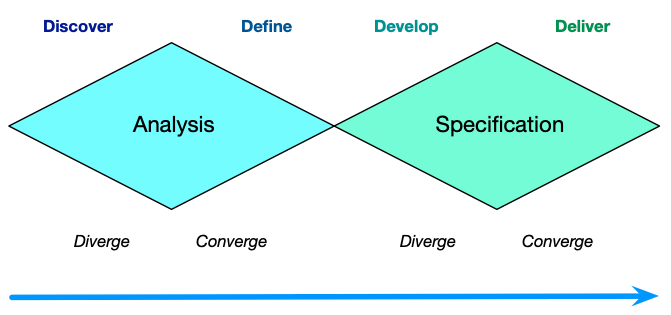Ideally, we’d have teams doing all our design and development. There are benefits to working together, not just for the innovation and creativity, but also for process. We can watch out for other’s mistakes and limitations just as they can look for ours. However, it can be costly to run teams when an individual will do. So, the question becomes, when do you team? And, for learning experience design I’ll suggest there are a couple of key places.
 Now, we want to team when we want diversity for creativity, for sure. As ‘design thinking‘ tells us, we want to diverge before we converge. Further, on both identifying the problem, and when designing a solution. The typical representation is the ‘double diamond’ that graphically represents divergence and convergence at both stages.
Now, we want to team when we want diversity for creativity, for sure. As ‘design thinking‘ tells us, we want to diverge before we converge. Further, on both identifying the problem, and when designing a solution. The typical representation is the ‘double diamond’ that graphically represents divergence and convergence at both stages.
Who you use in each phase may differ, of course. When doing analysis, you’re likely going to want to pull in subject matter experts (SMEs) as well as potential audiences. That can include not only experts in the theory, but also those who observe the actual performers, e.g. managers or supervisors. You want to triangulate not only on the principle, but the practice, because they don’t always agree(!).
Then, you’re likely to want to pull in team members to review what’s been seen or known before you proceed. We brainstorm, come up with some ideas, and they get taken away to be developed to the next level. Depending on the scope of your team and what you’re working on, that might be still with a smaller team, or an individual. However, if we iterate (and we should) we should converge again to check on the interim stages before moving on.
This includes for development as well. So, when you’ve got something to test, you’re going to want to bring in individuals with greater and greater representativeness to the final audience as you get closer to a final design. (BTW, there’s a lot packed into that sentence.)
We also want to minimize disruptions to our process. The goal is to find the minimal points that offer the greatest benefits to the outcome. It’s painful to totally redo a process, and typically is unnecessary. In general, most processes try to follow a sensible process. Thus, only small tweaks can lead to large improvements in quality.
So, the answer to “when do you team” is when the benefits of the collaboration outweigh the costs of the coordination. And that’s typically where you want diversity to improve the outcome. Creating ways to ‘show your work‘ is a shortcut to some of this input, but actively generating times to coordinate into design processes ensures that you’re getting the benefits.
Leave a Reply